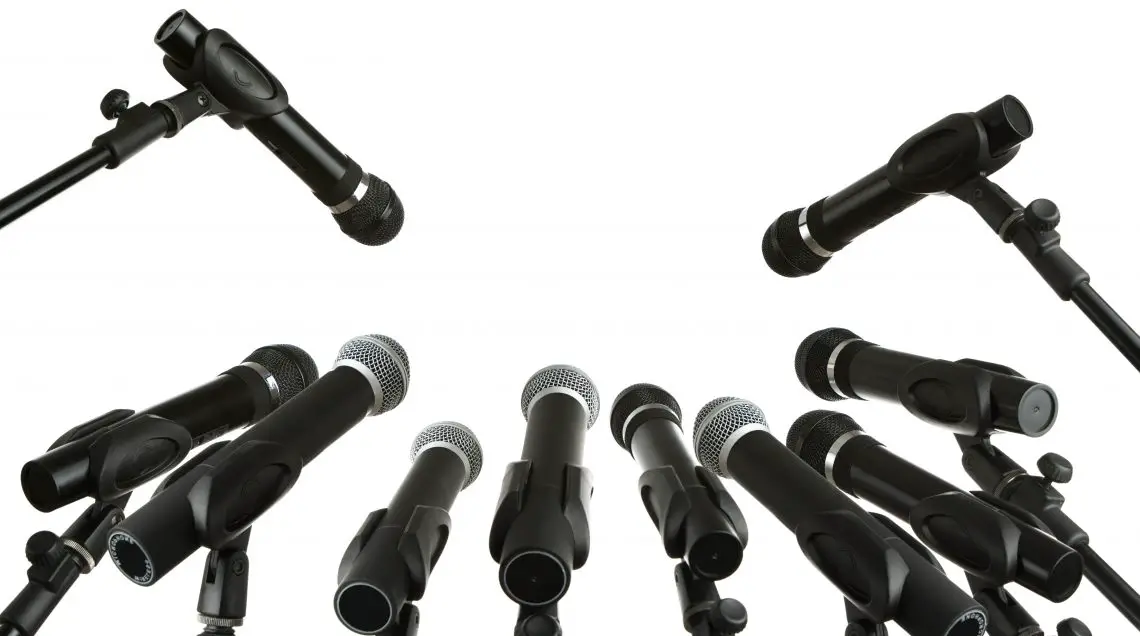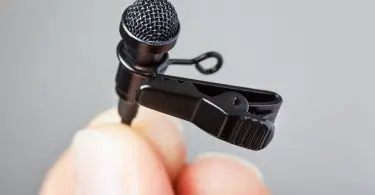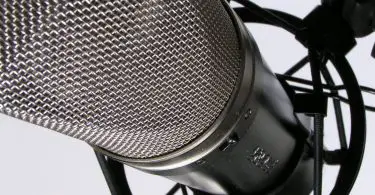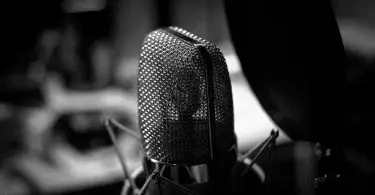What’s the worst experience you’ve had during a live onstage performance? We surveyed a savvy bunch of people in the public eye and they agree that tripping over wires holding webs of mic stands, floor monitors, and cables has led to 50 shades of embarrassment for the folks we chatted up.f
Dare we remind you of plastic bottles tucked into strategic places that “couldn’t possibly start rolling” far enough to trip one or more members of your entourage?
Face it. Floor space is everything. Particularly when the venue is tiny and your equipment is better suited to a sports stadium.
The only solution? Wireless, of course. You knew that, right? Need a succinct introduction to the wonderful world of wireless microphone systems? Check out this video for the basics of wireless mics:
-
 $1,049.00Check on Amazon Check on Musician's Friend
$1,049.00Check on Amazon Check on Musician's FriendGet full vocals with a handheld transmitter fitted with an e945 super-cardioid capsule. Up to 32 compatible frequencies and bandwidth is 88MHz, 3,520 tunable UHF frequencies, an Ethernet port for computer interface.
06/29/2025 01:23 am GMT -
 $238.48Check on Amazon Check on Musician's Friend
$238.48Check on Amazon Check on Musician's Friend200-Channel UHF Wireless Handheld Microphone System
06/29/2025 02:07 am GMT -

$159.00$149.00Check on Amazon Check on eBayAdjustable Channels UHF Wireless Cordless Handheld Microphone Mic System with a 400 ft range.
06/29/2025 03:04 am GMT -
 $659.00Check on Amazon Check on Musician's Friend
$659.00Check on Amazon Check on Musician's FriendWireless Microphone System for Two Performers (Lead and Backup Vocal Applications)
06/28/2025 09:16 pm GMT -

$126.99$64.31Check on Amazon Check on eBay2 MICS With 8 Selectable Frequency Channels, Independent Volume Controls, and AF & RF Signal Indicators
06/29/2025 04:07 am GMT -
 $409.00Check on Amazon Check on Musician's Friend
$409.00Check on Amazon Check on Musician's Friend2.4GHz Digital Wireless Handheld System
06/28/2025 04:06 pm GMT -
-
 $178.50Check on Amazon Check on eBay
$178.50Check on Amazon Check on eBayUHF Rechargeable Dual Channel Wireless System with 16 Frequencies
06/28/2025 11:15 pm GMT
Why Wireless?
Apologies to Joshua Tree’s “Trip Through Your Wires” lyrics, but let us count the ways your world benefits from an absence of wires. You’re able to cover the stage, arena or platform like a free-range chicken and set-up time is markedly decreased because you don’t have to worry about hiding all of that cable.
You can pull in a set-up crew with no previous knowledge of how to configure your stage since they won’t have as many details to worry about in the absence of those trippy wires.
Besides, “wireless is what all the big kids have,” and that should include you as updated technology, reliability and pricing make wireless not just the right choice, but the only one.
We don’t suppose you’d like our mom’s phone numbers, but absent that request, we can be trusted to advise you on wireless combination microphone shopping because we’ve been there and done that for more years than we care to cite.
Our research methodology can be described as dogged and we pride ourselves on reviewing a range of products so readers of all walks of life can find a product that suits their needs and budgets. Our team is made up of an eclectic mix of performers & technicians. Some of us hold technical degrees and most of us got into the business when there were no wireless devices, but we have no intention of revealing our ages.
Our Top Pick: Sennheiser EW 500-945 G3
Get full vocals with a handheld transmitter fitted with an e945 super-cardioid capsule. Up to 32 compatible frequencies and bandwidth is 88MHz, 3,520 tunable UHF frequencies, an Ethernet port for computer interface.
Think of your selection as an investment more than a purchase and you’ll understand why this unit earns our respect. The name may be unwieldy but the pedigree isn’t: At the end of World War II, engineer Fritz Sennheiser and lab partners worked assiduously at the University of Hannover to engineer a voltmeter.
As with all clever inventions, results exceeded expectations and the team produced a microphone that was henceforth miniaturized until the engineers had produced the DM3 invisible mic in 1949 plus mini-headphones a year or so later.

Credit: Sennheiser electronic GmbH & Co
In a single decade, techs working on this project numbered 250, and in honor of the dude who started the party, Sennheiser Electronic was born. If you like to play Trivia, memorize this factoid: Sennheiser is also responsible for the advent of the baby monitor.
Of course, you don’t want to wake baby, but you do want to be known as a discriminating shopper with good instincts, so sticking with the Sennheiser brand throughout the company’s history (it remains in the family to this day) makes logical sense.
You also get bragging rights. Because this set-up comes from the firm that has taken Academy Awards, Emmy Awards, and more, why the brand is so popular around the globe.
Specify the EW 500-945 G3 and you get a system that operates with 1,680 tunable UHF frequencies so you can kiss interference goodbye. There’s an Ethernet port for computer interface and you can feel free to take the unit on as many rough-and-tumble tour dates as you like because the sturdy metal case protects like an action hero.
The receiver features a rack-mountable display. See for yourself what the set-up looks like by visiting Amazon.
You want awesome, full vocals right? No worries courtesy of the handheld transmitter fitted with an e945 super-cardioid capsule. The frequency bank system sports up to 32 compatible frequencies and bandwidth is 42MHz.
And guess which wireless is most often chosen for the sound effects recorded for the top-selling video games on today’s market? We’re talking Assassin’s Creed, Guild Wars, Far Cry and Hitman, for example.
These games are recorded using Sennheiser equipment because the company’s wireless mics offer the best noise cancellation features, essential for delivering quality sound on stage or anywhere else for that matter.
We would be remiss if we didn’t offer a word of caution: Four-star popularity, performance and reputation send sales of this system into the stratosphere on a regular basis, so if you see it, grab it–before someone else does. The number of “Just one system left” notices on sites like Amazon aren’t to be dismissed as hype.
Runner Up: Nady U-2100
200-Channel UHF Wireless Handheld Microphone System
Though Nady has only been around for 40 years (compared to Sennheiser’s 70), the company has been busy catching up. An admirable force within the audio industry, Nady’s resume is packed with firsts.
It claims the first wireless guitar/handheld systems, professional head mic, wireless guitar/bass with built-in wireless, affordable pro wireless UHF PLL frequency agile wireless and more.
John Nady is the father of “companding,” the sound quality technique that boosts dynamic range. He filed for the patent in 1976, thus our runner up has its own dynastic contributions to the field of wireless combination microphones.
Some musicians wouldn’t consider another brand and Nady also boasts an Emmy Award for technical excellence.

Credit: Nady Systems, Inc
The Nady U-2100 setup includes two handheld mics that feature “neodymium dynamic cartridge” sound assistance, feedback is minimal and with an operating range of up to 500-feet, big rooms are no problem for this system.
Reviewers and musicians preferring this wireless combination microphone set-up are won over by 200 available UHF frequencies and contemporary IF filtering capability that allows users to operate up to 10 transmitters in concert.
The system’s memory stores channels and the receiver’s RF/AF graph display alone has won over fans.
Though pricier than our top pick, the Nady U-2100 boasts feedback from fans who are happy to pay more for a system they believe outshines Sennheiser, and we’re not arguing with them one bit.
7 Honorable Mentions
Picking honorable mentions for this dynamic product category is no easy job since the field is burgeoning with brands.
Each one claims its wireless microphone systems are superior, but we’ve conducted extensive research into those most favored by everyone from critics to buyers and offer the following suggestions.
GTD Audio G-622H
Adjustable Channels UHF Wireless Cordless Handheld Microphone Mic System with a 400 ft range.
Folks in need of good wireless mic service are not shy about offering opinions on the G-22H, especially a DJ whose 15 years of work in the field have exposed him to no shortage of brands, prices and quality.
His grand proclamation after just three weeks of auditioning the GTD? Awesome, problem-free and delivers on range and clarity. Likewise, a stage performer tested his system objectively for two months—gigs and rehearsals—and heaps praise on this unit’s range. He tends to scream lyrics in traffic as a sound check.
On the other hand, the traffic performer had run-ins with customer service after complaining that setting the gain on his GTD was nearly impossible.
Admitting that price was the object when another musician replaced his antiquated Shure system with the G-22H, he cited a broken antenna out of the box as being annoying, but he set that aside, fixed it himself and congratulated himself on getting a great deal.
Plenty of like-minded musician types are favorably disposed to this system–including this expressive “Wooooow unbelievable deal” exclamation from another 15-year veteran of the concert stage who took his equipment to a bathroom stall and enthused, “You cannot beat it; trust me” when commenting on sound quality.
More than one buyer commented that GTD and Shure displays are almost identical.
Is it all music and roses for shoppers? Not exactly. Returns have happened, but consensus seems to be that if you are financing your professional music career on a shoestring, the G-22H will serve you well—until you make the big bucks at which point price will be no object.
One warning: Stock up on batteries and make them the high-quality kind or you could find yourself in full lip-synch mode when you most need to be heard.
Shure BLX288/PG58 Combo
Wireless Microphone System for Two Performers (Lead and Backup Vocal Applications)
Next to Sennheiser, Shure has managed to build quite the fan club over time and for reasons unknown, shoppers tend to use the word “excellent” more often than not when offering feedback about this company’s wireless combination microphone.
Just about every aspect of this system follows the word excellent: vocal quality, range and automatic channel scanning. It’s hard to find purchasers who dispute this system’s price point.

Credit: Shure Incorporated
It’s a quality rig that’s particularly popular among church officials seeking the right sound system to broadcast religiously and clearly so churchgoers don’t nap during sermons.
Compliments include weight, a serious factor for those schlepping heavy instruments and electronic gear and fast set-up is also celebrated by purchasers. Did battery life also get the love?
Not always. On average, only five hours from fresh to dead was the consensus of reviewers, so as long as you’re not going to need your setup to go all night, this wireless microphone system won’t disappoint.
Has everyone had the same battery experience? A couple of musicians swear the batteries used in their Shure BLX288/PG 58 last between 12 and 14 hours, but perhaps they lost track of time while enraptured during their onstage experiences.
Expect to spend some money for your set-up, but how can you place a price on clarity, easy set-up and sound qualities?
For the instruction-averse, Shure gets extra points for technical writing that assists readers who are more focused on performance art than their ability to understand any instruction guide that’s ever been written.
PylePro PDWM3375
2 MICS With 8 Selectable Frequency Channels, Independent Volume Controls, and AF & RF Signal Indicators
What’s not to love about the 1960s? The British invaded, folk music hung on tenaciously and psychedelic rock was introduced to a nation of music lovers eager for beats to accompany this era’s dramatic lifestyle changes.
As all of this was going on, a company named Pyle began fabricating “advanced woofers,” but as time passed, the manufacturer diversified so stealthfully, by the year 2000 it had established a rightful place in the professional audio and musical instrument industry with its PylePro line of audio equipment.

Credit: Pyle Audio
The PylePro PDWM3375 wireless handheld mic system makes our list because we encountered so many skeptics-turned-believers during our research.
Musicians and performers were happy to tell the world that they were wrong when they doubted this two-channel UHF mic system that supposedly allows one to “stack as many systems as you have frequencies.”
Could this PylePro mic possibly live up to promises found in the unit’s marketing materials?
Still skeptical yourself? You may belong to this crowd if the price stopped you in your tracks because the PDWM3375 costs around $100, though you will need extra cash on hand to load up on AA batteries.
Complaints include being too loud (one musician keeps this system console set at 70-percent volume), but if you hope to play Chicago’s Grant Park and reach folks on Michigan Avenue you’re going to need this much range and lots more.
Owner recommendations include upgrading to an XLR cable, otherwise, to quote one wordsmith, “PylePro is killing it with quality semi-pro audio.”
Audio-Technica ATW-1102
2.4GHz Digital Wireless Handheld System
At about the same time PylePro was producing those advanced woofers, Audio-Technica began to spread its wings across the audio equipment spectrum in 1962, claiming it had a lock on problem-solving audio gear.
Corporate walls must be filled to capacity with awards from myriad industries because Audio-Technica equipment has been chosen over others at Olympic events, within the U.S. House of Representatives and Senate, broadcast studios and broadcast events that include Grammy ceremonies and Rock & Roll Hall of Fame inductions.

Credit: Audio-Technica U.S., Inc
The Japan-based corporation is a major force in Asia and the company prides itself on advanced technology, thus the introduction of the ATW-1102 was expected to live up to its pedigree.
That said, nothing’s perfect and battery-life complaints have hindered this system’s ability to earn five of five stars consistently, but ATW-1102 owners are quick to praise simple set-up and engineering that all but eliminates feedback—even up to four feet.
As a traveling musician reports I’ve put this ATW-1102 system to test within venues seating over 1,000, yet I did not experience any interference, static or signal loss. After that experience, I was completely won over as well after discovering the crystal clarity of my live recordings.
A DJ whose taste for Audio-Technica died over time was shocked to find in the ATW-1102 a renaissance of sorts. “Sound quality is fantastic!!” (yes, there were two exclamation marks) said the brand returnee who added that he has yet to experience signal drop outs since getting back into bed with this “stellar performer.”
The ultimate compliment? One system owner reports having his ATW-1102 mic stolen.
Azden WMS-pro
Founded in Japan in 1952, Azden joined the ranks of audio innovators when the industry began to blossom. Among the company’s strongest focuses are the development of mics and wireless audio equipment for video production.
With deep roots in wireless technology beginning in 1967, Azden pioneered the electret-condenser microphone. Three years later, development and production of magnetic-head and condenser microphones launched a technological revolution for this brand.
While corporate roots remain in the far East, Azden USA has become the firm’s epicenter of innovation and pioneering product introductions. But it’s the feedback from owners like this one that tell the Azden WMS-pro story best: “I loved it so much, this is my second purchase.”

Credit: Azden Corporation
This system costs less than $100 so could expectations possibly have been met when it comes to performance? In fact, plenty of Azden owners are happy to go to the mat for this company and its latest wireless mic system.
Clear sound paired with “an amazing price” caused one owner to brag about sound quality compliments that lead to friends buying their own units.
A motivational speaker known for toting her system enjoys the ease of setup and says she has no complaints about battery life. Waxing poetic about flexibility and freedom, she’s not the only shopper seeking solutions to problems that assailed her as a result of buying a pricier brand.
I found that this system has limitations typically found in inexpensive systems: lackluster performance when used to span distances greater than 20 feet, and the occasional complaint about tonal quality when the mic is positioned a foot from the speaker.
We also noticed manufacturing inconsistency but considing this simple, affordable investment exceeds expectations, it’s fine.
Audio 2000’S AWM6123U
UHF Rechargeable Dual Channel Wireless System with 16 Frequencies
Compared to competitors whose beginnings harken back half a century, Audio2000’s is the relative new kid on the block.
Founded as a subsidiary of H&F Technologies in 1989, the company had already established itself as a wireless, digital player in the professional sound industry, but diversifying into this new division allowed H&F to focus efforts on the advanced audio technology contemporary musicians, performers and audio technicians crave.
Summing up the AWM6123U wireless system you get some good old fun that won’t cost you an arm and a leg.
Good sound quality and a better-than-average operating range are often listed as reasons to buy this Audio 2000’s product. You can forget about spending half of your equipment bonus on batteries because the AWM6123U comes with an NiMH rechargeable.
LED readouts earn points as do separate level adjustment features and fans claim a benefit that not every mic we’ve covered in this review addresses: it feels good in the hand.
Is this inexpensive wireless microphone setup perfect? Hardly. Non-changeable frequencies can be a turn off. Aesthetically you might consider that the mics are a little penis-shaped. If aesthetics matter to you, consider that feedback.
But we applaud the sound quality, excellent ability to take abuse and solid construction.
Reports of noise, interference and drops are scant and an amazing number of shoppers cite affordability mixed with positive reviews as the prime reason they chose this system when making their buying decision.
How to Choose a Combination Microphone
Wouldn’t it be great if you could hire an expert in wireless combination microphones to pick out the best, most affordable system while you spend your time rehearsing instead?
But like all folks in the music industry, it’s incumbent upon you to do your homework so you become a quasi-expert on the topic yourself. Start out by asking pertinent questions like the following to begin your shopping journey.
Where will your system be used?
No brainer here unless you intend to audition your wireless mic in a bathroom and don’t want to reveal your practice space.
If you’re fortunate to know your fixed location up front, make sure you’re operating on either VHF or UHF frequencies or you could find yourself interfering with other wireless devices in addition to TV broadcast airwaves.
On the other hand, let’s say you’re on the road again more often than Willie Nelson, traveling around to myriad locations, cities and venues. You need a system that’s “frequency-agile” so you can adapt to local conditions, no matter what they may be.
Like things even simpler? Opt for automatic frequency selection equipment to stay nimble. That technology rules and it’s only going to get better.
How many wireless microphones do you intend to use at any time?
According to the lyric written by Harry Nilsson and made famous by Three Dog Night, “One” is the loneliest number and has been since the hit was introduced in 1969.
Your need for just one mic is no cause for holding a pity party because if you have no reason to invest multi-mic systems, your start-up purchase won’t suck up your entire working budget.
Need two or more systems? Expect a balancing act because each operates on a different frequency. If you don’t know what you’re doing, interference between your wireless microphone setups could create problems.
That said, if given the option, choose mics programmed to select frequencies that are compatible so this is a non-issue.
What are the advantages of wireless combination microphone systems?
Dare we repeat an earlier claim that freedom of movement is everything when an artist is in the moment? You avoid replacing cable that gets ravaged, especially during exuberant performances.
Band members who were born accident-prone and klutzy don’t have to buy extra health insurance. You avoid bouts of “galvanic isolation” that can turn you and fellow performers into electricity conductors.
And the disadvantages?
The biggest is limited range. If you intend only to play small rooms, think of this as a benefit. Occasional interference may still lurk courtesy of nearby radio equipment or microphones.
You will be perpetually at the mercy of battery life. Nothing drains batteries faster than transmitter circuitry. Carrying extra batteries at all times is a pain in the neck.
Wireless mic technology is still vulnerable to dead spots or noise. Plain and simple: Keep your wallet out. Wireless has fewer features yet costs more. Go figure.
Will you choose UHF or VHF wireless microphones?
There are advantages to prioritizing Very High Frequency systems (VHF) because that’s what the pros use, so why not you? Ultra-High Frequency systems (UHF), on the other hand, have reputations for longer range paired with less interference.
Apart from user preference, there are more advantages to UHF simply because it’s been around longer and the bugs have been addressed and solved.
If numbers impress you, drop this factoid next time you seek attention: UHF makes available eight times the frequency of VHF.
Life in the frequency lane is changing at meteoric speed so it’s incumbent upon you to keep tabs on this topic as both bands are becoming overloaded, according to audio gurus.
Analog or Digital?
Does it ever end? Of course not. That’s why it’s called progress. But if you are asked to choose between analog and digital, know what you’re talking about.
Digital wireless systems convert audio signals snagged by the mic into a bitstream within the transmitter, directing that signal to the receiver.
Digital systems eliminate a need for companding–the word refers to the process taking place when dynamic signal range is reduced during the recording phase and expanded to its original value for playback.
Digital eliminates radio-frequency issues for all intents and purposes. Conversely, pricier analog wireless microphone systems are becoming so well-engineered, they rival their digital cousins when it comes to “dynamic range” and interference resistance.
Perhaps the biggest distinction between the two has to do with latency, defined as short delay periods measured in milliseconds between the time an audio signal enters and emerges from the unit’s main control system.
Those preferring analog technology don’t have to worry about latency while digital wireless aficionados can expect differing amounts. Latencies of 15ms are typical and tolerable, but for the person using the mic, lower is better if he wants to monitor output via an earbud or headset.
How to Set Up and Use Your Wireless Combination
Give thanks for YouTube offering an endless menu of how-to guides so you don’t zone out reading text. This handy set-up tutorial can get you started, and this one can help you interface your speaker and your wireless mic.
Armed with helpful hints, add these three set-up tips to your repertoire:
- Always provide a clear line of site between the receiver and transmitter. Sound like a no brainer? You wouldn’t believe how many newbies haven’t a clue. Audition, audition, audition after set-up to avoid last-minute confusion.
- Become obsessive about checking battery life and always bring spares just in case. This is the sort of preparation that makes mom proud; especially moms obsessed with reminding you to always carry extra pencils and paper when you were in school.
- If given a choice, pick a “diversity” receiver. Radio frequencies, like boomerangs, bounce off surfaces if not directed properly. With a diversity receiver, you get redundancy to cover this possibility: two antennas and two demodulators.
History
Thought you were out of school, correct? Not so fast. Life is an ongoing educational process and every bit of background you possess on how wireless technology has come to be a driving force—specifically as it applies to combination microphones—is going to pay off.
These are deep roots grounded in 1940s and 1950s wireless radio history, thus if you’re big on vintage and longevity, you may wish to know that the Shure Brothers are credited with introducing the first performer-designed wireless mic, which boasted a 15-foot range.
Innovation and experimentation drove global companies forward. Some failed. Others thrived. Considered the break-out firm in 1957 was Germany’s Lab W, a company that later came to be known as Sennheiser. Under the purview of American electrical engineer Raymond A. Litke, wireless technology became a necessity at political convention venues, Olympic events and stage performances.
Under the purview of American electrical engineer Raymond A. Litke, wireless technology became a necessity at political convention venues, Olympic events and stage performances.
Litke was granted a patent in 1964, when his systems were marketed exclusively by Vega Electronics. At around the same time, Sony and Nady Systems jumped in, introducing the first compander wireless microphone preferred by music icons like Todd Rundgren and the Rolling Stones.
In 1996 Nady, Sennheiser and Vega all received Emmy Awards for their contributions to developing broadcast wireless mics.
Recap of the Best Wireless Mics
Get full vocals with a handheld transmitter fitted with an e945 super-cardioid capsule. Up to 32 compatible frequencies and bandwidth is 88MHz, 3,520 tunable UHF frequencies, an Ethernet port for computer interface.
200-Channel UHF Wireless Handheld Microphone System
Adjustable Channels UHF Wireless Cordless Handheld Microphone Mic System with a 400 ft range.
Wireless Microphone System for Two Performers (Lead and Backup Vocal Applications)
2 MICS With 8 Selectable Frequency Channels, Independent Volume Controls, and AF & RF Signal Indicators
2.4GHz Digital Wireless Handheld System
UHF Rechargeable Dual Channel Wireless System with 16 Frequencies










One of the spots we play gigs had the ew100 version of the Sennheiser for some time. They were good. But then they decided to upgrade the receiver and capsule, going to the ew500. All I can say is Wow… What a big difference! Major upgrades to the clarity and tone. Real amazing. On top of that the gain controls. Worth the dollars invested I’d say.